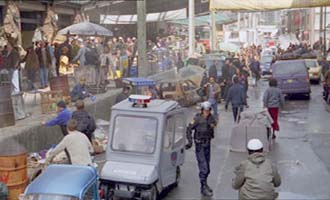|
Set in 2020 post-apocalyptic America, Dark Angel is
the story of Max, a genetically engineered fighting machine
on the run from the government. She is living and working
in Seattle, a dangerous area which is still trying to recover
after terrorists killed the US economy by detonating an electromagnetic
pulse. As Season one is about
to be released on DVD (£59.99) and video (£39.99)
by 20th Century Fox, Sci-fi-online brings you Max's guide
to surviving a nuclear attack...
The
detonation of a nuclear bomb over a target such as a populated
city like Seattle causes immense damage. The degree of damage
depends upon the distance from the centre of the bomb blast,
often referred to as the "hypo-centre" or "ground zero".
The
closer you are to ground zero, the more severe the damage.
Damage is caused by several things including: a wave of intense
heat from the explosion, pressure from the shock wave created
by the blast, radiation, and radioactive fallout (clouds of
fine radioactive particles of dust and bomb debris that fall
back to the ground), and an electromagnetic pulse (EMP).
Imagine
a very bright flash in the sky! No one is hurt but, your transistor
radio stops playing, your car won't start, the telephone doesn't
ring, lights go out, and we suddenly find ourselves in the
Stone Age. This is an electromagnetic pulse, or EMP. Electric
and magnetic fields created by a nuclear explosion cause the
destruction of all electric and electronic circuits. If exploded
in high altitude, a nuclear device could create a massive
EMP without any other type of nuclear blast damage.
The
development of modern high-tech semiconductor devices permeates
the developed world. Communications have been made faster,
automobiles more fuel-efficient and maintenance-free, TV sets,
videotape recorders, and virtually every other piece of electronic
equipment have been improved by the advent of the semiconductor
and its high-tech advancements.
A
nuclear attack on the North American continent could bring
the country to its knees by frying all of the circuitry in
our electronic equipment. All nuclear explosions produce EMPs.
The induced voltages and currents produced in conductors (wires
and cables) are comparable in strength to the strongest of
lightning bolts. EMPs may reach 3 million volts and 10,000
amperes for a total of 30-billion watts of energy.
The
largest commercial radio stations in the US and Canada radiate
50,000 watts, or approximately one-millionth that much power!
Indeed, three ten-megaton thermonuclear weapons detonated
250 miles above the United States or Canada would produce
EMPs strong enough to knock out the entire electrical power
grid of North America including the entire civilian-telephone
network, and just about every broadcast station. Virtually,
every piece of unprotected electronic equipment in the country,
radios, TV sets, computers, electronic controls in homes,
office buildings, factories, cars, aeroplanes, and instruments
in hospitals, would be damaged, if not destroyed. The pulses
would also damage or destroy large portions of the military
command's control and communication system, and chain reactions
would also be set in motion at nuclear power plants.
 |
With
a typical nuclear attack, at the hypo-centre, everything is
immediately vaporised by the high temperature (up to 500 million
degrees Fahrenheit or 300 million degrees Celsius). Outward
from this, most casualties are caused from burns by the heat,
injuries from the flying debris, and acute exposure to the
high radiation. Beyond the immediate blast area, casualties
are caused from the heat, radiation, and fires spawned from
the heat wave. In the long-term, radioactive fallout will
occur over a wider area because of a prevailing winds. The
radioactive fallout particles will enter the water supply
and be inhaled and ingested by people over a great distance
from the blast.
In
the 1980s, scientists proposed the theory that a "nuclear
winter" could occur. In this scenario, the explosion of many
bombs would raise great clouds of dust and radioactive material
that would travel high into Earth's atmosphere. These clouds
would block out sunlight. The reduced level of sunlight would
lower the surface temperature of the planet and reduce photosynthesis
by plants and bacteria. The reduction in photosynthesis would
disrupt the food chain, and cause mass extinction of life,
including humans.
 |
Nuclear
weapons have incredible, long-term destructive power that
travels far beyond the original target. These horrific set
of possibilities are why the world's governments are trying
to control the spread of nuclear bomb making technology and
materials and to reduce the nuclear weapons that were deployed
during the Cold War. There
is always the danger of a rogue nation or terrorist group
getting hold of a nuclear device and causing a global catastrophe.
Many have already tried to obtain the necessary equipment
and knowledge. Some may soon possess it, if they haven't already.
Whether
it were the result of a terrorist or the first salvo of an
all out nuclear war, what you did during the first few moments
following a nuclear blast would mean the difference between
life and death.
You
can survive quite close to ground zero if a small nuclear
device explodes. A good shelter can be the ticket to surviving
a nuclear attack and you could survive a similar blast even
if you're just a mile from ground zero. Of course, the farther
you are from ground zero the better off you'll be.
For
this reason, one good survival strategy is to be away from
areas that are apt to attract attacks. Big cities may be glamorous,
but they are prime targets for attack. Those living close
to large harbours or military installations are also most
at risk. Moving away from such areas will probably keep you
safe from limited nuclear attack for the rest of your life.
The release of energy during the explosion super heats the
air around it until it is hotter than the face of the sun.
This air expands violently making a blast wave that races
from ground zero at up to 4,000 miles per hour (fortunately
this speed drops off quickly as the distance from ground zero
increases). The air ahead of the blast wave is compressed;
it bends light and appears slightly luminous and will appear
as a sheet of glass moving out from the centre of the explosion.
As the blast wave storms away from ground zero, the fireball
that created it rises so quickly that it creates a vacuum
under it. The vacuum pulls air back toward ground zero so
that the blast wave is followed by a counter wave sucked back
toward the area of the explosion to fill the vacuum. Both
the blast wave and the counter suction wave are destructive.
All
in all, you won't have trouble knowing a nuclear explosion
has occurred especially since its fireball will be four times
as bright as the sun.

With
thanks to Paula at DSA
Season
one of Dark Angel is out to buy on 24 February 2003
from 20th Century Fox Home Entertainment
(£59.99 DVD & £39.99 Video)
Return
to...

|